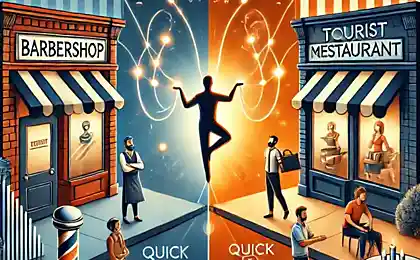How to create viral content, the formula for success

Together with the rotation search engine to users and user account factors about which we have written many times on our blog, become interesting related issues, such for example as the relationship of the theory of planned behavior and the spread of viral content. This text presents the evaluation of the viral potential of the example of the now legendary campaign Scarecrow from Chipotle. Unique viral video has been viewed over 13 million times, not only because of the wonderful animation and a well planned campaign that included including the motivation of user activity through the application. For the development of the concept of viral material is a whole science, which told Christine Latin. In the spring of 2014, she published the article in the blog YouMoz Blog. The material is rather controversial as his submission, however, it touches a topic that is close philosophy product SocialTask : information noise from your content in social Media can get much easier than it seems. Translation made for and placed with the permission of the analytical department of the company ALTWeb Group .
Translation is given in abridged and slightly altered for ease of understanding the form. I>
When creating content for the site we are faced with a daunting task: to create content that resonates with our audience, stimulates activity and often spreads virally.
We have to spend a lot of time watching what is already working and you always want to build process based on living examples of learned lessons. One critical factor is the need to again and again to refine the content until we do not feel that there appeared viral potential, and that the user can "stock up" on what he saw. What are the main components of this process? What is the formula for creating a successful viral content? And here's how:
Yes, perhaps, is a bit scary, but I will refresh you, it really is not that difficult. Let's see together.
Click on the right buttons h4>
Let's start with the assumption that each person in your audience and potentially want to share your content, just does not know about it. Click on the right buttons for the right people - and voila! - Great virusnyak.
Which buttons in question?
The theory of planned behavior h4>
In 1985 Aysek Aizen, who is currently a professor of psychology at the University of Masachussetskom, developed a theoretical basis for the model to explain and predict human behavior. Since then, the theory of planned behavior is widely used to explain human behavior and has been exhaustively studied in a number of scenarios. Today we apply this theory to the exchange of online content.
The theory of planned behavior argues that each of us makes a decision (rational) support or not a particular type of activity. Accordingly, a reasonable explanation for the adoption of a decision is based on finding the number of discrete variables and, therefore, if you can identify each of these variables, you can predict behavior.
Details of the theory:
Theory of planned behavior can be divided into four components:
to the behavior (AB) The subjective norm (SN) The perceived behavior control (PBC) behavioral intentions (BI) < / Using these elements, we can simplify the formula I quoted earlier in this article.

Now let's define some terms to better understand the significance of this equation.
attitude toward the behavior (AB) h4>
Whoever throws some information in their own understands the potential positive and negative effects in response to what has shared, as well as the severity of these effects. This is the attitude toward the behavior. There are two main points:
1. The way the fissile content evaluates the potential consequences of their actions (e)
In a situation of behavior associated with the distribution of content, this group of potential impacts that may occur as a result of action taken (and the one who distributes content, understands it).
2. The strength of the potential consequences (b)
In our case, this is how, again, spreading the content, we appreciate how powerful it will be. Could it be that by spreading some content, we assume that those for whom it is intended, it may perceive ambiguous. In this case, this variable will show HOW ambiguous content will be accepted.
From this point of view, let's look at an example of a campaign Chipotle. This video tells the darkly artificial food industry and is aimed both at raising awareness of the audience, and to draw attention to the fact that Chipotle offers an alternative in the diet.
This installation requires a detailed study of its own position on the issue otherwise there is a risk of losing. After all these videos Chipotle could provoke discontent companies who hold the opposite views on philosophy. Nonetheless, Chipotle weigh the pros and cons, and decided to launch a campaign: obviously came to the conclusion that the positive effects will be more rather than negative.
A number of comments were really negative, remember that Chipotle sells soda (obviously not compatible with the principle of utility power - approx. Trans.), And complaints that the concomitant application of the campaign did not have a version for Android.
But on the whole campaign was greeted very positively received and more than 11 million views on Youtube with more than 61,000 likes and rating of 3, 5 star in applications. Here, clearly, the negative consequences could not outweigh the positive.
Subjective norm (SN) h4>
This is as a distributor of information is a potential reaction of his audience. This is what motivates him or may not correspond to certain norms and beliefs of those who see the content.
This segment also can be divided into two sections:
1. The strength and depth of the norms and beliefs of those who see the content (n)
Attached to our situation, this figure is derived from the general public expectations about the behavior and norms that are important to your audience. And it tells how far these expectations in a society rooted.
2. The strength of the motivation to adhere to certain norms forcing (m)
In our case it is our assessment of impacts associated with how the content matches (or does not meet) the standards and expectations of society, which it will be presented. In simple terms (time to be long - approx. Pens), this is how you imagine the reaction of your audience for content.
Before Chipotle has launched a campaign Scarecrow («Scare Crow" - approx. Trans.), Most likely, the study found that people are concerned about the quality of the food they consume. The campaign would enable them to reach this audience and worried at the same time educate and reassure.
If they make a mistake, the entire strategy would be imploded, and they would have sounded as moralists.
The perceived behavior control (PBC) h4>
This is how communicators understand the factors that may limit or facilitate the contrary behavior, as well as the strength of these factors. Like the previous elements of the formula, this also can be divided into two components:
1. Controls (c)
In our case all the factors that make the content distribution task easier or more difficult. Geography or technology that may hinder or accelerate the dissemination of information?
2. The strength of the controls (p)
The annex to the situation of content distribution, this variable is a rough estimate of the content distributor to how hard or easy it will be to spread content.
Chipotle campaign faltered in this case on the Android system for which an application has not been written. However, this proved not such a big obstacle strength, and many lacked just a movie. Well, the team itself Chipotle tried to and about the video and the people learned about the application and it would be easier to share them.

If we take the sum of all of these factors and their components, we can predict behavioral intentions t. E. Attractive content for the user, or the extent to which it generally want to share this content. Thus, the formula will be as follows:

How to apply the formula in practice h4>
We disassembled into components impetus for causing a user desire to share content. We need this in order to be able to think carefully over each component to most accurately evaluate the factors that affect the ultimate behavior of the user. To share our content, or not? Let's start here with what:
How can I use the attitude toward the behavior (AB):
Recall attitude toward the behavior (AB) defines the positive or negative effects and their effect \ severity. The consequences can be different:
The type and strength of emotion which content will cause a response. People are being extremely prone to emotion and empathy, so we have developed an evolutionary many ways to share emotions, starting and ending with facial complexity of human language or body language. We are adapted to impart not only the ideas but also the associated emotions. The same applies to the way we share content online. Content conveys emotions, and we really strive to see the reflection of his own emotions in those who care about us. When we share content has spread to us emotionally, we potentially would like to respond to feel those emotions again and relive the moment when they first felt. This is one reason why the emotional content content often is warm and cozy character. People are more willing to share content that will make others feel good, rather than the content, of which all feel bad. The stronger positive emotional reaction, the higher the content viral potential. If you share content negative, then realize that getting such content and will act on the basis of proven negative emotions. Therefore, negative content share only if there is another, extra motivation, some added value content, in addition to the emotions as such. The way reflects the content of the one who shared them. Content can be viewed as a continuation of his own ego. This is another reason to share content, including because it allows us to gain a foothold in their own point of view, in how we perceive ourselves. We think about how this content will affect how others see us, but also how this content allows us to better understand ourselves. Pay attention to your own habits: how you share content on Facebook. You may well see who of your friends are more interested in politics, or in the family who have rather good mood, and someone depressed and so on. D. All of this can be assumed only by the type of content that they share. We all share something each time more clearly oharakterizovyvaya themselves. What tangible benefits for you from what you share content? New York Times published an interesting study on what pushes us to share content. The conclusion of the study is that we share our content if we can be of tangible benefits. Research suggests five major motivations for distributing content: Share useful or entertaining content with others. According to the poll, 94% of the respondents evaluated carefully, as they spread the content will be appreciated by those who would see him later. Show yourself to others. Content sharing to better identify their priorities, both for themselves and for others. Develop and strengthen their relationship. In 78% of the respondents admitted that share content to maintain contact with those who had little contact. Feel "Connected." 69% of respondents thus feel their connection to the world. Tell about some business or brand. 84% of respondents admitted that they so declare business or brand, in which they believe. What it all means: If the content is simply carries information, we are unlikely to get a viral effect. We need to cause strong emotions in the reader. If the article, graphic or video catchy enough, the reader does not even think to share them, because there is no initial emotional experience that I would like to go through again, or do something related to the topic. blockquote >
How Subjective norm (SN) can be used to amplify the viral effect:
Recall that the subjective norm (SN) is how you disseminating information, understand how your content complies with the audience. Subconsciously, we always consider the following things from this category:
How content is related to the accepted norms? Even if the content is entirely consistent with your standards, but it may be contrary to some norms audience, you're more likely to slow down and will not rush them to share. It is important to note that the audience is important, therefore, social norms can vary greatly depending on the audience. Most often, we may distinguish different groups with different (or the opposite) subjective normami.Sravnite with its own behavior. If you want to share the latest release of the Comedy Club, you can think about is if your page is read some of your friends or relatives who look only public television channels. How much moral norms influence the distribution content and how pronounced the consequences might be in breach of these rules? If you know that content would be contrary to the subjective norms of your audience, it does not always stop you. To begin, you will think about how severe it will be. Not all social norms are perceived equally. For example, murder is not consistent with the concept of rules of behavior in society, but not coughing behind his hand - it also does not match. So you first vzvevshivaete for and against, and then can make a decision to break the rules or not. Could the audience to act as a rogue, contrary to the rules? This can be if sharing content, we do not take into account all the rules, but only rules of a particular individual, often one that can serve as a source of the most powerful effects. So, your behavior will be different depending on whether you have in your friends head or not. The rules may also differ depending on the channel through which information is disseminated. Anonymity here will play a huge role, as it can remove all any hesitation over whether or not to share content. If a person does not get any effects, the behavior becomes more straightforward. It is important to take into consideration, t. To. The different communication channels have different levels of anonymous users. If you have an account on 4chan, Reddit, Facebook, and Twitter, you most likely will share a variety of content through these channels. Not only subjective norms will differ depending on the selected channel, but also the desire to meet them.
What this gives us: When you come up with and implement the content, remember that not everyone with the same willingness to share certain kinds of content. Conduct research with the aim of your CA to find out what they most often share that discuss. And then create their own content on the patterns obtained.
How can I use the perceived behavior control (PBC) to create viral content:
Recall that the perceived behavior control (PBC) takes into account the factors that facilitate or inhibit behavior. Namely: How long will it take to share pictures. All that will facilitate this process, you need to do. Simplicity is the most important. Even if you add just a couple of seconds in this process, for example, hiding somewhere click "share", you may lose the opportunity of interest to the user. How much effort will have to make. Make all you can, do. For example, automatically add the text to which the link will be posted on Facebook or Tweeter. Have technical difficulties. We need to make sure that the content was not as easy to share as read it. For example, check the Embed infographic that nothing was awry. Check that the elements normally reflected in all browsers.

























